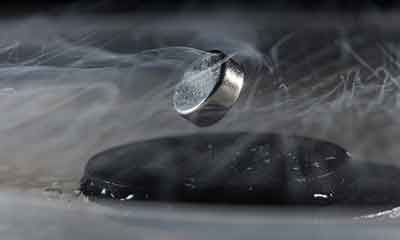Date: 16/03/2023
Relevance: GS-3: Science and Technology- Developments and their Applications and Effects in Everyday Life.
Key Phrases: room-temperature superconductor, quantum computers, Electricity transmission, Nitrogen-Doped Lutetium Hydride, revolutionize technology, Meissner effect.
Why in News?
- The discovery of a room-temperature superconductor has caused a stir among researchers worldwide, representing a significant breakthrough in the fields of physics and materials science.
Superconductor:
- A superconductor is a material that can conduct electricity with zero resistance when it is cooled below a certain temperature, known as the critical temperature or Tc.
- When a superconductor is below this temperature, electrons can move through the material without any resistance, allowing for the creation of extremely powerful magnets and highly efficient electrical systems.
- Superconductivity was discovered by Heike Kamerlingh Onnes, a Dutch physicist, and his team in 1911.
- Not only do superconductors carry electricity with essentially zero electrical resistance, but they also possess the strange ability known as the Meissner effect that ensures zero magnetic field inside the material.
Current Limitations of Superconductors:
- Electricity transmission is hindered by the resistance in wires and cables, leading to losses of power.
- Superconductors, discovered a century ago, can conduct electricity without resistance, which could lead to revolutionary technologies, including quantum computers.
- However, the superconductivity in known materials occurs under specific circumstances, usually at very low temperatures.
- Scientists have been searching for a material that can superconduct at room temperature and pressure for decades.
- All the materials we know to be superconductors become that way in
special circumstances; outside those circumstances, they resist the flow
of current.
- For example, aluminium becomes superconducting at a cold temperature of less than –250° C.
Finding a Room-Temperature Superconductor:
- Physicists and engineers have been toiling to find materials that superconduct electricity in ambient conditions, i.e. at one or a few atmospheres of pressure and at room temperature.
- The theory that explains why some materials become superconductors in some conditions suggests that hydrogen and materials based on it could hold great promise in this pursuit.
- In 2019, scientists in Germany found lanthanum hydride (LaH 10) to be a superconductor at –20° C, but under more than a million atmospheres of pressure – pressure that is only realised at the centre of the earth
Nitrogen-Doped Lutetium Hydride:
- Researchers in the U.S., led by Ranga Dias at the University of Rochester, reported discovering room-temperature superconductivity in nitrogen-doped lutetium hydride at roughly a thousand atmospheres of pressure, which is on the face of it a great advance.
What did these investigators do that was new?
- The Key Material:
- The researchers identified the presence of nitrogen as the critical factor in achieving superconductivity.
- They developed a high-pressure synthesis process to introduce nitrogen into the crystal of lutetium hydride.
- The Right Amount:
- Superconductivity in the material is brought about by the (microscopic) jiggling motion of the crystal, and the investigators intuited that the right amount of nitrogen could induce the right amount of jiggling: to produce superconductivity at room temperature without destabilising the crystal.
- The Results:
- In fact, the nitrogen-doped lutetium hydride is stable in ambient conditions (with blue colour) but is not yet superconducting.
- However, when subjected to a thousand atmospheres of pressure, the material turned red, indicating a change in the nature of the electrons.
- The material showed a sharp drop in electrical resistance around room temperature, expelled magnetic fields, and a hump in heat capacity, all indicative of superconductivity.
- They found superconductivity in approximately 35% of the samples tested.
Techniques in question
- The group inferred that the material's electrical resistance had dropped to zero by collecting resistance data and then subtracting the contributions from sources other than the material.
- This procedure's validity has to be carefully ascertained, and some experts have already expressed an inclination to reject the technique as being unfounded.
- The measurement of the material's diamagnetism also suffers the same criticism. The authors have developed a new method to measure the heat capacity, which they claim to have validated using a known superconductor, magnesium diboride (MgB2). This method also requires careful vetting.
Controversy Surrounding the Principal Investigator
- The principal investigator, Dr Ranga Dias, has had a controversial past, including a retracted claim of room-temperature superconductivity in a carbonaceous sulphur hydride.
- Some physicists have accused him of scientific misconduct, including fabricating data.
Conclusion:
- Despite the criticisms, the discovery has sparked scientific curiosity, and researchers will continue to explore ways to reproduce the results.
- The fact that the superconductivity occurred at a thousand-times atmospheric pressure allows for more research groups to enter the field.
- A room-temperature superconductor could revolutionize technology and have a significant impact on industries such as energy, transportation, and computing.
Source: The Hindu
Mains Question:
Q. What are the challenges and potential benefits associated with discovering room-temperature superconductors, and what recent developments have been made in this area of research?







